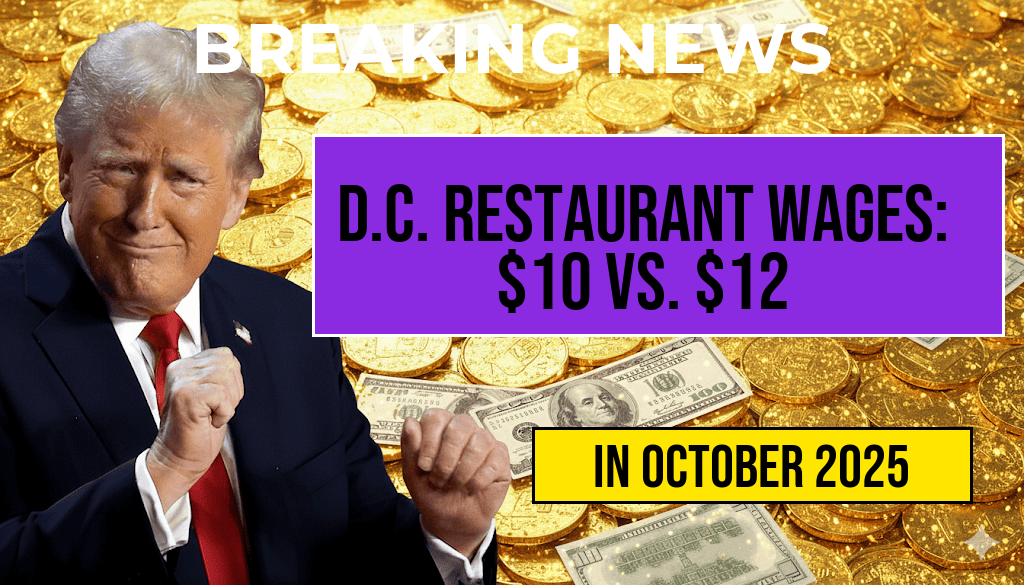Workers in Washington, D.C., employed in the restaurant industry are facing a significant wage disparity due to recent local policy decisions. The district has upheld a $10 minimum wage for tipped employees, which remains the baseline for restaurant staff, despite mounting evidence that this rate leaves workers substantially below what they could earn at higher hourly wages. When compared to a hypothetical $12 per hour rate, typical for many service industry jobs, restaurant workers earning the district’s mandated minimum are effectively earning $4,160 less annually. This gap raises questions about the adequacy of current wage policies and their impact on frontline workers, especially amid rising living costs in the nation’s capital.
Background on Washington, D.C.’s Wage Policies
Washington, D.C., has long been a leader in establishing progressive labor standards, including a minimum wage that is higher than many other jurisdictions. As of 2023, the district’s minimum wage stands at $16.50 per hour for most workers. However, for tipped employees—such as restaurant servers—the minimum is significantly lower, set at $10 per hour, with the expectation that tips will supplement this base. The rationale aligns with federal guidelines, which permit tipped minimum wages to be lower than the standard rate, provided total earnings meet the minimum wage threshold after tips are included.
The Wage Gap Calculation
To understand the financial implications of the district’s policy, consider a typical scenario:
- At $10 per hour: A worker earns $10/hour, working 40 hours weekly, amounts to $400 before tips weekly, or approximately $20,800 annually, assuming no time off.
- At $12 per hour: The same schedule yields $480 weekly, totaling about $24,960 annually.
Subtracting these figures reveals an annual difference of roughly $4,160 in earnings, illustrating how the $10 minimum wage leaves workers significantly behind those earning even just $2 more per hour. This gap becomes more pronounced when considering the financial strain of housing, healthcare, and other essential expenses in the D.C. metropolitan area.
Impact on Restaurant Workers
Many restaurant employees rely heavily on tips to supplement their base wages. Critics argue that the current policy effectively shifts the burden of fair compensation onto customers and the workers themselves, potentially leading to inconsistent income streams. According to the U.S. Bureau of Labor Statistics, tipped workers in urban centers often depend on a combination of wages and gratuities that can fluctuate based on business volume and customer generosity.
Workers’ Perspectives
| Hourly Wage | Weekly Earnings (40 hours) | Annual Earnings (52 weeks) |
|---|---|---|
| $10 | $400 | $20,800 |
| $12 | $480 | $24,960 |
Many restaurant employees report that their tips can vary significantly week to week, which complicates financial planning and stability. Several workers have voiced concerns that the current wage framework does not reflect the rising costs of living in D.C., where housing prices have surged by over 20% in the past two years, according to Zillow.
Policy Debates and Future Outlook
Advocates for raising the tipped minimum wage argue that maintaining it at $10 perpetuates economic inequality among service workers. They point to studies showing that higher wages translate into better quality of life, reduced turnover, and improved service standards. Conversely, restaurant associations and business groups caution that increasing wages could lead to higher menu prices and potential job cuts, especially in a competitive hospitality market.
Potential Policy Changes
Legislators in D.C. are examining various proposals, including phasing in higher minimum wages for tipped workers or eliminating the tipped wage altogether. Some proposals suggest aligning the tipped minimum with the standard minimum wage, ensuring that all workers earn a consistent baseline regardless of gratuities. Such measures aim to address the wage disparity and bolster economic security for thousands of restaurant employees.
Broader Economic Context
The wage dilemma in D.C. reflects a broader national conversation about fair pay and worker protections in the service industry. As inflation persists and living expenses climb, the adequacy of tipped wages remains a contentious issue. According to labor experts, a more equitable approach could involve revising the tipping wage policy to better reflect current economic realities and ensure stable incomes for frontline workers.
Additional Resources
Frequently Asked Questions
What is the current minimum wage for restaurant workers in Washington D.C.?
The current minimum wage for restaurant workers in Washington D.C. is maintained at $10 an hour.
How does the $10 minimum wage impact restaurant employees’ earnings?
With a $10 an hour minimum wage, many restaurant workers earn significantly less than they would at higher rates, resulting in an average earning gap of $4,160 compared to a $12 per hour rate.
Why does the wage dilemma persist despite the higher minimum wage?
The dilemma persists because restaurants are required to pay a minimum of $10 per hour, which, combined with tips and other factors, leaves workers earning substantially less than they could at a $12 per hour rate.
What are the potential benefits of raising the minimum wage for restaurant workers?
Raising the minimum wage could close the earnings gap, improve workers’ financial stability, and increase overall job satisfaction within the restaurant industry.
Are there any recent policy discussions or proposals related to increasing restaurant wages in D.C.?
Recent policy discussions have focused on whether to increase the minimum wage beyond $10, but as of now, D.C. maintains the $10 base salary, leaving the wage dilemma unresolved.






